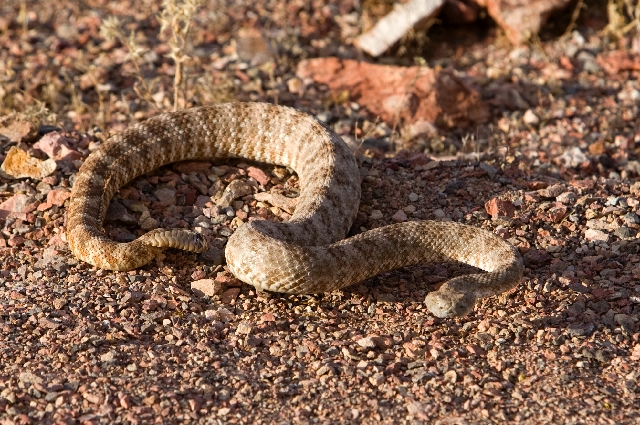Be alert – rattlesnakes enjoy pleasant spring weather in the desert, too

One early summer evening, my friend Ron and I decided to shoot our muzzleloading rifles in the remnants of an old gravel pit located in the desert near my home. At the time, such activity was still legal in that area, and we wanted to take advantage of the somewhat cooler temperatures that come with the setting sun. What we didn’t count on was running into someone else who wanted to take advantage of the cooler temperatures as well.
As I organized powder and ball, Ron grabbed our target and began walking toward an earthen bank that would serve as our backstop. When he was about halfway there, Ron suddenly stopped and shouted something about the funny sounding crickets we have in these parts. That made my ears perk up and I listened closer. What Ron heard was a rattle … the rattle.
The cricket turned out to be a rattlesnake whose course of travel lay directly in Ron’s path. Fearing for his safety, the snake rattled his tail as a warning that Ron was getting too close for comfort. Heavy scales above its eyes that somewhat resemble horns helped us identify the snake as a sidewinder, one of four rattlesnake species that are native to Southern Nevada. The other three are the speckled, Mohave and western diamondback rattlesnakes. Each one is venomous and can pose a danger to you or your pets.
The likelihood of crossing paths with a rattlesnake varies with everything from location to daytime temperature. For example, the pleasant temperatures we experience this time of year make the desert a more hospitable place to be than it will be in July, when temperatures push beyond the 110-degree mark. Therefore, more people will be recreating in the outdoors now than will be during the hot summer months. Likewise, snakes will be more active during the daylight hours now than they will be a couple of months from now. A similar situation exists in the fall when daytime temperatures begin to cool.
Recognizing that rattlesnakes come with living in the desert, and learning to identify them are the first steps toward making your outdoor experience a safe one. Another step is learning to be observant and to take some simple precautions when out and about.
Keep in mind that not every snake is a venomous snake. Rattlesnakes have a broad head that resembles a triangle, and their body is very thick in the middle but tapers just behind the head and at the tail. Of course a rattle on the tail end can be a dead giveaway, if a snake has them. Nonvenomous species are characterized by a narrow head, slender body and a pointed tail.
When hiking in the desert, look ahead and watch where you place your hands and feet. This is especially true in rocky or brushy areas and very important for rock climbers. When stepping over a rock, log or other obstacle, look on the other side before you take that step. If you walk with children or with a dog, keep an eye on them. If they suddenly get curious about something on the ground, take a closer look; snakes have a way of attracting their attention.
Snakes do frequent the shoreline at area reservoirs and other bodies of water, so boaters need to take similar precautions when stepping from their vessel onto the shoreline.
Keep in mind too that when you feel hot and think about finding a shady place out of the sun, so do snakes. Look before you sit in the shade of a rock or tree. A snake might already be there. Caves, crevices and abandoned structures can be inviting to the curious, but they are also inviting to snakes looking to get out of the sun.
Since snakes like areas with cover where they can hide and easily move in and out of the sun, campers should avoid those areas. Instead, select a campsite that has open ground so you can see and snakes won’t feel comfortable. Even so, campers should always check their tent, bedding and shoes before stepping into them. One never knows who might come for a visit.
Freelance writer Doug Nielsen is a conservation educator for the Nevada Department of Wildlife. His “In the Outdoors” column, published Thursday, is not affiliated with or endorsed by the NDOW. Any opinions he states in his column are his own. He can be reached at intheoutdoorslv@gmail.com.












